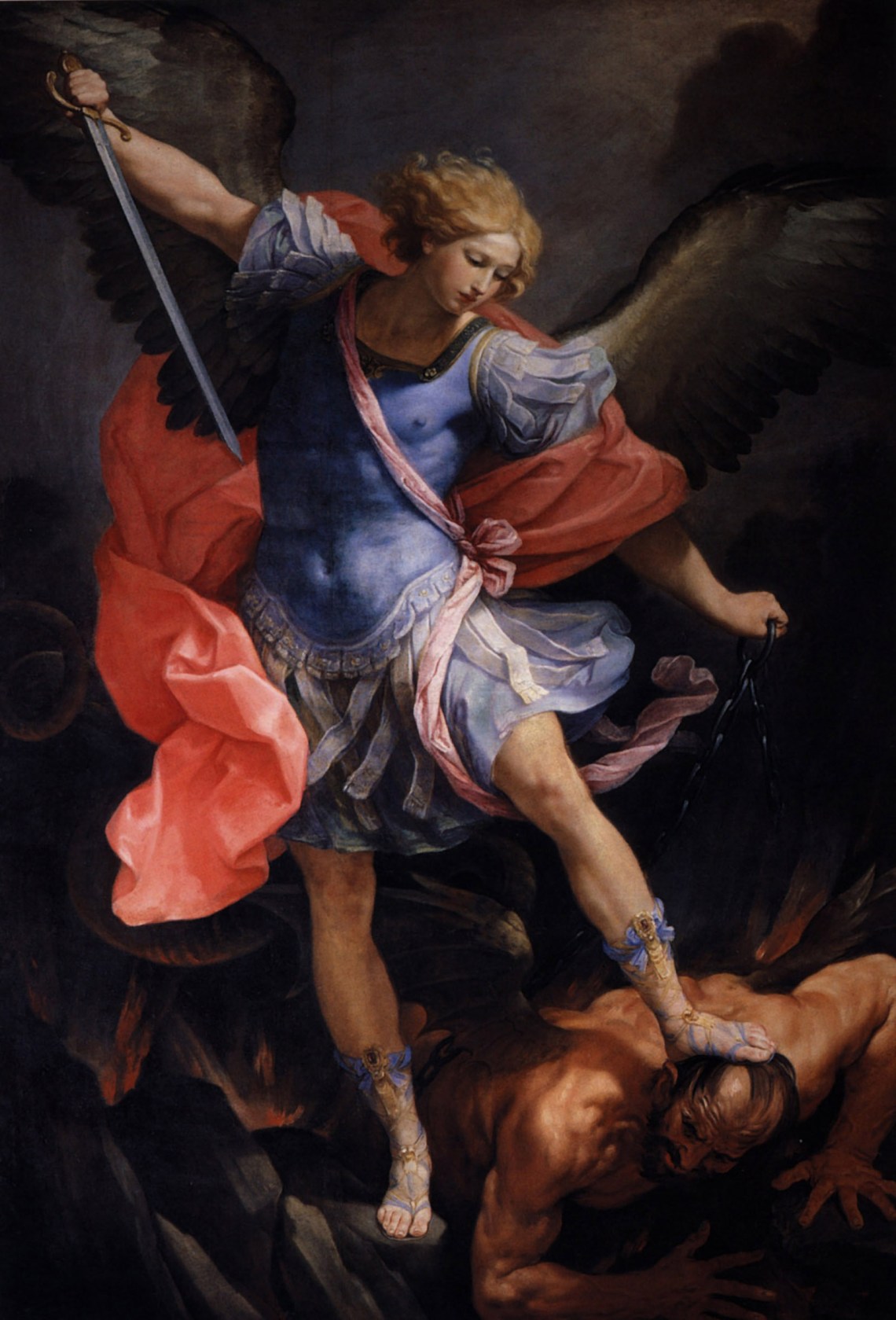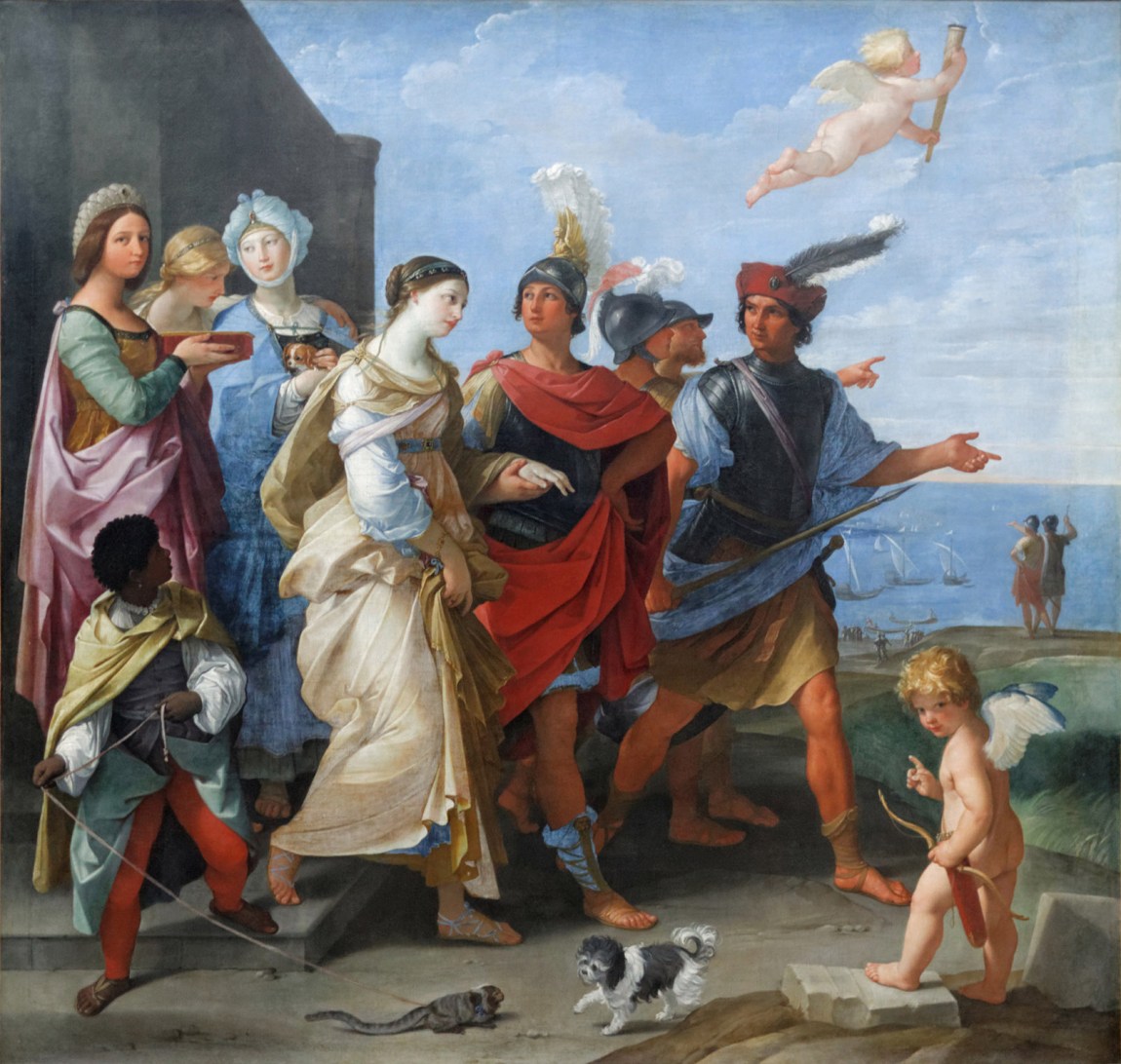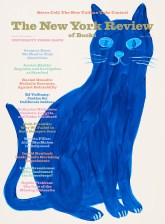The Roman church of Santa Maria della Concezione sits atop a precipitous cliff of volcanic stone that frames the modern Via Veneto. Most visitors climb a flight of outdoor stairs to see the crypt, whose five chambers are packed with the skeletons and mummified bodies of 3,700 Capuchin friars, many of their bones attached to the walls and ceilings in elaborate Rococo patterns. A second flight of stairs leads up to the church itself, and to the spectacle that drew visitors long before the crypt received its macabre decoration in the eighteenth century: Guido Reni’s painted vision of the archangel Michael consigning Satan to the depths of Hell. The Book of Revelation describes the cataclysmic struggle:
And there was war in heaven: Michael and his angels fought against the dragon; and the dragon fought and his angels,
And prevailed not; neither was their place found any more in heaven.
And the great dragon was cast out, that old serpent, called the Devil, and Satan, which deceiveth the whole world: he was cast out into the earth, and his angels were cast out with him.
When Reni completed his altarpiece in 1636, Italy had recently seen its own share of apocalyptic struggles: a deadly resurgence of bubonic plague from 1629 to 1631, the eruption of Vesuvius in 1631 after centuries of quiescence, a second eruption in 1632, the eruption of Mount Etna in 1633 and 1634, and an endless stream of distressing news from the front lines of the decades-old battle between Catholics and Protestants in Germany. Pope Urban VIII quarreled with his cardinals about whether the earth revolved around the sun or vice versa and whether the Virgin Mary, like Jesus, had been born without sin. He pressed them to convict Galileo Galilei of heresy in 1633, against the advice of his cardinal nephew Francesco Barberini, and refused to pronounce on the Virgin’s Immaculate Conception, so Urban’s brother, Cardinal Antonio Barberini, endowed a new church in honor of the Virgin Immaculate and commissioned Reni, whom contemporaries called “the Divine Guido,” to depict Saint Michael’s cosmic battle in the first chapel on the right-hand side of the church, the first thing visitors are likely to see after passing through the narrow vestibule.
Reni painted his imposing Saint Michael the Archangel Defeats Satan not on canvas but on silk, spun in his native Bologna. The seams between the bolts of fabric still show through the layers of paint, along with the fine weave and luminous surface of the silk itself. A window on the chapel’s right-hand wall casts natural light on Hell’s red-hot, spiky crags as they smolder like the crater of Vesuvius, filling the vast caverns of Hades with a sooty pall. Among the flames we can just make out the bat wings sprouting from the fallen angel’s muscular back; above his dragon hips, this Satan has the physique of a Michelangelo. Prostrate, he struggles mightily to raise himself, but the back of his head has met an immovable obstacle: the archangel’s elegantly sandaled foot.
Like Lucifer’s leathery wings, Saint Michael’s grayish-brown pinions nearly blend into their mephitic background, focusing our attention entirely on his angelic body in its skintight ultramarine blue armor and the salmon-pink cloak that billows up around him on infernal winds. If one of Reni’s contemporaries had painted this scene—Caravaggio, say, or Artemisia Gentileschi, or Jusepe de Ribera—we would be thrilling to the extremity of its violence: Good holding Evil in thrall at the climax of the Apocalypse. The violence is certainly present: as Michael steps on the head of his adversary, he rattles Lucifer’s chain with his left hand, while his right hand aims a dramatically foreshortened sword straight at the Evil One’s throat. The archangel’s body twists in three dimensions, every limb, including the wings, flung outward, as his mantle, his rose-colored baldric, and the lappets of his armored skirt blow wildly around him, but the light of the chapel window, like the light within the painting itself, centers on his perfectly poised right foot, set lightly but decisively on a flat spur of infernal rock, the colors of his intricate footwear echoed by a lavender glimmer in the deep background: the path that will lead Michael, and us, back to the upper world.
In effect, Reni managed his paintbrush as masterfully as Michael manages his sword. A slash of lead-white paint on the archangel’s forehead emphasizes both the depth of his concentration and Reni’s presence as an artist—he liked to finish off his consummately polished productions with a few random strokes—but this angel, unlike Caravaggio’s gritty figures, is not one of us. He looks, if anything, like Apollo come down to earth, his imposing figure certainly influenced by the artist’s careful study of ancient sculpture as well as living human beings. Reni’s Saint Michael quickly became an image almost as famous among his contemporaries as the ancient statue known as the Apollo Belvedere.
Advertisement
The victorious archangel also bore a strong theological message. The twelfth chapter of Revelation, which tells of his triumph over Satan, begins with a vision: “And there appeared a great wonder in heaven; a woman clothed with the sun, and the moon under her feet, and upon her head a crown of twelve stars.” In 1627, guided by this biblical passage, Reni had portrayed the Virgin in his Immaculate Conception as a young woman standing on a crescent moon in a burst of radiant gold, a halo of twelve stars framing her head. The painting went off to Spain, spreading both the artist’s fame and the association between the twelfth chapter of Revelation and the hotly debated doctrine. In a church explicitly dedicated to Mary of the Immaculate Conception, Reni’s painting of Saint Michael enlists the fighting forces of Heaven to endorse the doctrine of her sinless birth. Yet for all the power of his physique and the fierceness of his pose, the most impressive proof of the archangel’s authority rests in his supernal composure, in his ability to keep a swirl of titanic forces under rigorous control.
This spring Madrid fluttered with banners advertising a comprehensive exhibition dedicated to Reni at the Prado, curated by David García Cueto in an impressive debut as head of the Department of Italian and French Painting Up to 1800. (The banners may not have been woven of silk, but they brightened the city with Reni’s inimitable colors.) After an initial biographical section, the show, with nearly one hundred works on display, pursues three general themes: Reni and Spain, his study and portrayal of the human body, and his relationship with sculpture, both ancient and contemporary—his admirers included Gianlorenzo Bernini.
Reni was born to a Bolognese musician and his wife in 1575, but rather than following the family profession he apprenticed around the age of nine to Denys Calvaert, a Flemish painter residing in Bologna, a prosperous city with an important artistic tradition of its own, independent of Florence, Venice, and Rome. From Calvaert Reni absorbed the idea that drawing was fundamental to all the other visual arts, becoming such a precociously accomplished draftsman that Calvaert engaged him as a thirteen-year-old to teach drawing to the other apprentices. Still in his teens, he finally left Calvaert’s workshop around 1594 to join the Carracci—brothers Agostino and Annibale and their cousin Ludovico—whose artistic academy hosted Bologna’s most avant-garde ideas in art and literature. (The city’s university, founded in 1088, claims to be the world’s oldest.)
In 1601 Reni began traveling to Rome, where he settled in 1604 and stayed until 1614, making side trips to Bologna and Naples. Handsome, fervently religious, impeccably dressed, he never married, and even after returning to Bologna, his home until his death in 1642, he lived and conducted his illustrious international career in a series of rental properties, as restless in life as he was in art. From the outset, his exceptional technical skill afforded him an unusual degree of artistic independence; he learned as much from antique sculpture and earlier artists, especially Raphael, as he did from his mentors, Calvaert and the Carracci.
In some respects the painter, immensely popular in his own day, poses a challenge to contemporary taste. Revolutionary artists are supposed to follow the script of the magnificent rebel (to borrow the title of a 1962 film about Beethoven), transgressing the boundaries that constrain them, struggling heroically, plunging headlong into the pressing issues of their times. But Reni, like his Saint Michael, makes stupendous combat look deceptively simple. Unlike Leonardo’s failed experiments with oil paint on plaster walls or Michelangelo’s unfinished (and unfinishable) Captives, Reni’s artistic innovations usually worked: coating a copper plate with a thin layer of pewter to keep the metal from oxidizing, painting in oil on silk—anything that might increase the refinement or durability of his art. The unusually good condition of his surviving paintings shows just how successful he was in his efforts. (Aoife Brady’s catalog essay on his technique is a mine of information.) A thorough professional, he drove a fierce bargain with his patrons but was otherwise an affable soul, equally at home among artisans and aristocrats.
In other ways, Reni has a distinctly contemporary appeal: his relentless experimentation was, in fact, a perpetual struggle, and along with Caravaggio he stands out among his contemporaries for his sovereign sense of human dignity. In Rome he was struck by the gravitas of a wizened, elderly dockworker (described as a schiavo, which could mean a Slav or a slave), whose face he sketched and then modeled in clay to serve him as a model of wise old age. We see him performing the holy operation in The Circumcision of Christ (1636), as an enraptured Saint Luke (circa 1625), and transformed into an elderly woman for the monumental Triumph of Job (1636; a loan from the cathedral of Notre-Dame in Paris).
Advertisement
Reni’s devotion to the Immaculate Conception, which accorded Mary the same sinless status as Jesus, carried through in his regard for women in general. His Abduction of Helen (1631) is no abduction at all: the Spartan queen is fully complicit with the Trojan lover who prepares to sweep her across the wine-dark Aegean.
The Prado exhibition sets Reni’s Girl with a Rose (circa 1636–1637) next to Jacopo Tintoretto’s provocative Portrait of a Lady Revealing her Breast (1580–1590), possibly depicting the poet Veronica Franco—an arrangement that may repeat the way these two panels were long displayed in Madrid’s Alcázar. Tintoretto’s subject audaciously bares her breasts to the viewer while averting her head disdainfully; she seems to suggest, in no uncertain terms, that the artist has purchased access to her body, but her self, and her integrity, remain beyond his reach. Reni, who may have been celibate, paints his Girl with a Rose from the difficult vantage he had come to master—a three-quarter profile, seen slightly from below—and presents her dressed in white, an image of purity.
And then there is the timeless appeal and sheer joy of his artistry, the quicksilver variety of his drawings, and his endless adventures with paint. One segment of the exhibition is dedicated to the theme of flesh and drapery, in Reni’s hands at once the most representational and the most abstract of subjects. He probed the unpredictable ways in which the addition of green or blue paint could impart a pearly shimmer to skin, how two colors placed side by side necessarily reflect each other, and the expressive power latent in a billow of cloth. The exhibition is filled with paintings on similar themes, but not one of them exactly copies another; each new effort reveals some further variation in posture, in color, in technique, even in his later years when gambling debts forced him to speed up his production.
Because he was such a revered figure in his own day and in subsequent centuries, it is easy to see Reni today, with his cool, controlled manner, as an academic painter in the nineteenth-century sense, but the Prado exhibition convincingly dispels that idea, revealing him instead as a tireless innovator. His contemporaries may have seen his work as divine, but Reni protested that what they saw resulted from hard labor. The visual quotations from Raphael and ancient sculpture are not simply learned citations: each one has been reconceived in three-dimensional space for the entirely new composition in which it finds itself. These familiar figures are the means to an end, clues from fellow artists who have ventured down this path before. Reni applies their skill, and his, at reproducing nature and the human figure to reveal what interests him most of all: giving form to visions beyond the reach of normal sight, from the transcendent realms of Heaven to the divine potential shining within each human soul.
An early drawing by Reni, Rest on the Flight into Egypt (circa 1598–1600), places Mary, Joseph, and the infants Jesus and John the Baptist in a lush landscape that has little to do with Egypt, much to do with the forested slopes of the Apennines above Bologna, and everything to do with the magical capacity of pen and ink to suggest foliage, twisted tree trunks, and distant villages perched on cliffs. Three versions of Saint John in the Wilderness, all from the 1630s, set different figures of the saint, with different physiognomies, within variations on the same Apennine landscape, and in each one Reni experiments with the effect of using brushes of different thicknesses to portray such disparate textures as leaves, bark, rock, fur, and human skin. A sensual red chalk drawing of a young bearded man is displayed as Head of Christ (1620), but what we have before us, in marvelous foreshortening, is a vibrantly carnal human being before Reni’s brush has transmuted that carnal glow into his painted figures’ aura of divinity.
Around 1630 or 1631, the artist painted one of several versions of a favorite theme of Caravaggio’s, David and Goliath. The Prado exhibition displays this David next to the museum’s own Caravaggio painting of the same subject (circa 1600). Guido’s first encounter with Caravaggio’s dark, dramatic style impressed him deeply, most visibly in his brilliant rendering of another famous Caravaggio theme, the Crucifixion of Saint Peter (1604–1605), but his David with the Head of Goliath reflects an artist at the height of his own popularity. Caravaggio’s David is still a boy, dressed in a simple white tunic, a humble shepherd with suntanned skin, barely larger than the head of the slain giant. Reni’s David is a statuesque prince wrapped in fur, a jaunty red hat with an ostrich plume standing in for his royal crown, every bit a match for the head of Goliath.
Reni’s time in Rome also brought him into contact with Cardinal Cesare Baronio, who conceived the brilliant idea of applying archaeological methods to the study of early Christian monuments. The discovery of the body of Saint Cecilia in 1599 provided Rome with a tangible focus for the thrilling combination of archaeological exploration, spiritual renewal, and artistic inspiration that captivated the young emigrant from Bologna.
Reni’s first experience of Saint Cecilia had also been his first experience of his great model, Raphael, whose monumental painting The Ecstasy of Saint Cecilia (1516–1517) had been commissioned for a Bolognese patroness. The saint turns her head slightly upward as she listens to the heavenly music that has been miraculously granted her to hear, and the memory of this exquisite work, along with the excitement surrounding Saint Cecilia and her rediscovery, led the young artist first to copy Raphael’s altarpiece and then, around 1605, to try his own hand at rendering the challenging pose. It would become one of his trademarks, especially for women in distress, from his early paintings of Saint Apollonia enduring the removal of her teeth to legions of Cleopatras pressing asps to their snowy breasts, Lucretias plunging daggers into their hearts, and saints looking up to the empyrean—people poised on the border between life and death, mortality and eternity.
Still more daringly, monumental works like The Trinity Adored by Angels (1625) in Rome’s church of Santissima Trinità dei Pellegrini (which did not travel to Madrid) and the Immaculate Conception loaned from New York’s Metropolitan Museum of Art (like The Triumph of Job, a remarkable coup) fly free of Earth altogether, in an effort to give visual form to the firmament itself, to the blue expanses of the lower Heaven and the amber glow of its upper reaches. Two versions of Reni’s Agony in the Garden (1607) place the anguished Christ somewhere in the same celestial realm, far removed from the earthly olive grove of Gethsemane. The only reason Reni’s heavenly visions, so luminous in their simplicity, seem unsurprising now is because they became definitive once he had painted them.
The final room in the Prado’s tribute to the questing soul of Guido Reni shows the artist locked in a struggle with his most human foible: an incurable addiction to gambling. He loved a card game, but for all his talents, he never succeeded in beating the odds. To sell more paintings, he streamlined his methods, pushing the limits of what clients would accept as a finished work, making a virtue of thin paint, shortcuts, and reliance on light and shade to define his figures rather than his coruscating color. The last painting in the exhibition shows a Blessed Soul bound for Heaven, his lithe figure remarkably similar to the ancient torso displayed in tandem with him, his arms outstretched like the praying figures painted on the walls of the catacombs of Rome (which Reni knew). Clad only in a rippling pink drape, the expectant soul stands lightly on Earth as the sunny yellow realms of Heaven open above his head. This is how David García Cueto hopes we will remember the Divine Guido: as a visionary to the end.
This Issue
June 22, 2023
Fireball Over Siberia
Who Are the Taliban Now?
Meow!





